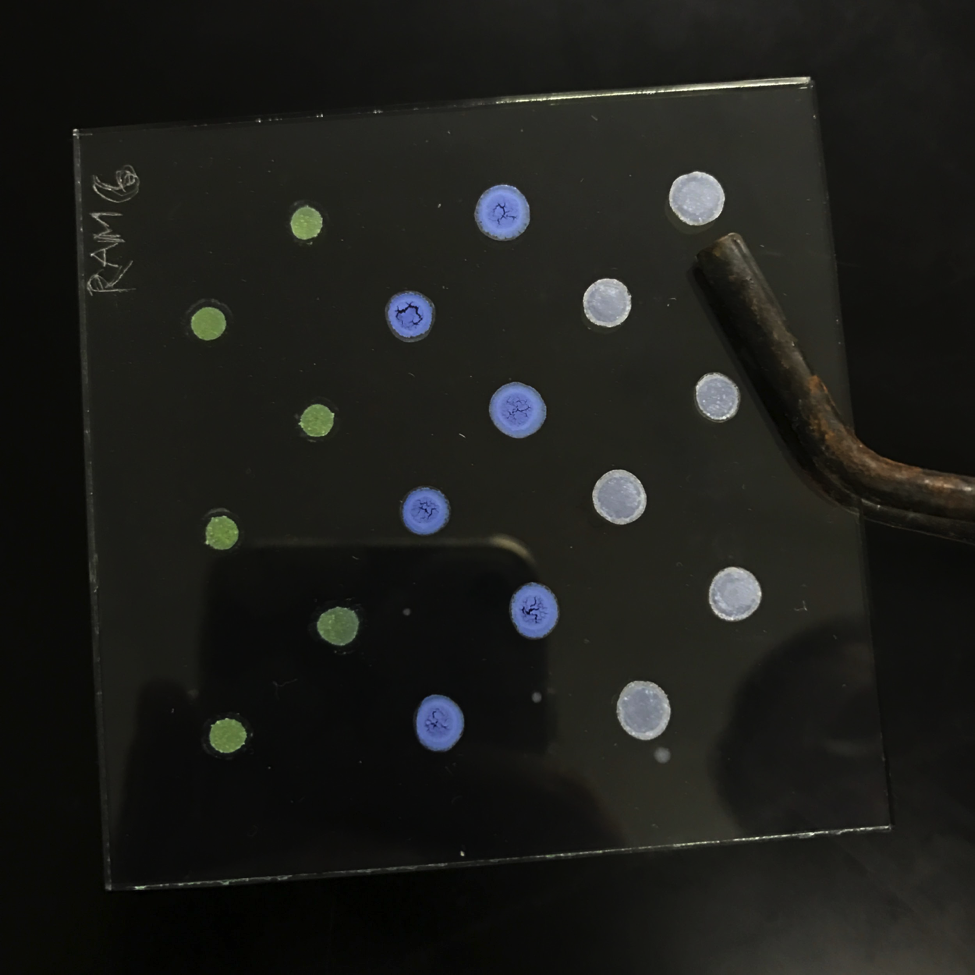Lots more updates this week! And we’ve had our first comments- Franklin and San Marino, check back at previous posts to answer some questions from fellow SEAL members.
Beckman HS is continuing work with their UV ozone cleaner. They are testing UV cleaning with iron (III) nitrate samples of various concentrations (0.1M, 0.04M, and 0.05M) as well as 0.04M copper (II) nitrate. They tested the 0.1M Fe(NO3)3 plate with the SEAL kit, but could not get the dark current to settle below 0.75 microamps.
The Oakwood team is also using their UV zone cleaner for a plate with iron salts, but with a lower concentration of 25mM. They used multiple different iron salts to test if the counterion or other additives affects the final iron oxide sample. After annealing, their iron plate had almost no coffee-ring effect and no flaking. Unfortunately they were unable to test the plate this time due to software issues.
The Poly team attempted to test one of their plates with the HARPOON kit for the first time. They had some trouble getting the solution purged and oxygen-free for testing. If you’ve done the HARPOON experiment before, please share some advice for the Poly team in the comments.
The San Marino Magic Wand team also had some software troubles this week, so they focused on making another plate to compare their dropcasted one from last time. The “magic wand” for electrodeposition was working so they were able to make a plate with 6 different samples with varying ratios of NaH2PO2, KH2PO4, and NiCl2. The samples with 1:4 ratios Ni:P gave a deep black color which seems promising, so three of the spots have that ratio. The plate will be annealed and ready for testing next time.
Finally, the three Mayfield subgroups have been working hard making lots of sample plates. SEA group is still working on testing their set of colored metal salts with non-colored salts. This week they made a plate comparing Bi, W, and Zn with Co, Fe and Ni. After some disappointing results from their BiVZn, BiZnCo, and BiZnCu samples, the RAM subgroup is modifying the samples to see if switching the metals will improve the activity. This week they made samples of CuW, CoW, and ZnW. Check out the beautiful colors of the samples below. The KEN team is building upon work they did last year with a successful FeZn material. Repeated testing of a new FeZn material yielded much lower results than last year, though spots closest to the epoxied wire did have significant current in the light blue region. Additions of cobalt to Fe and Zn and CoZn, tested with a varied ratio pattern, were unsuccessful.
Keep up the great work everyone. We’d love to hear from the rest of our teams too, so remember to update your Google Drive doc every week. Ask questions, comment, and get conversing with your fellow SEAL members. I know there’s lots you can learn from each other!


Our question is for the Oakwood team: why did you decide to lower the concentration to 25 mM instead of something lower? Is the 25 mM your golden number as of now?
Our question is for the Beckman SEAL team: does using the ozone cleaner seem to be beneficial for testing the SEAL plates?
Hi! I’m from Alverno Heights Academy’s team. I participated in the Summer SEAL program this year and did use the ozone cleaner a couple times. It seemed to me that after using the ozone cleaner, spots were more uniform and the coffee ring effect was greatly lessened. In terms of results, I’m not very sure but as the coffee ring effect likely affects photoactivity, it probably does change the results.
We also have a question for Mayfield: Did using different colored spots have any large effects on your results?
And another question for Beckman: We were also experiencing problems in trying to get the dark current below 0.5 microamps. Did it have a large effect on your results?
Also, here is our team’s contact email: alverno.solar@gmail.com
Thanks!
@Alverno: Our reasoning behind the use of the colored metals is that it would be more efficient in absorbing the light, and would therefore assist the reaction. We think using colored metals could be advantageous, however from the results we’ve gotten, it works more proactively when mixed with a more powerful, non-colored metal. So, the effect is not huge, but it does help.